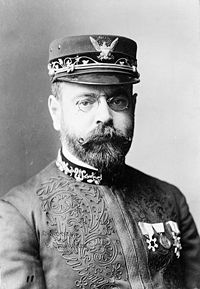

 John Philip Sousa “To reach every heart by simple stirring music...This was my mission. I wanted to make music for the people.” ~John Philip Sousa The American composer and band conductor John Philip Sousa is known as “The March King.” Sousa was born on November 6, 1854 in Washington, D.C. John Philip was the third of ten children of John Antonio Sousa and Maria Elisabeth Trinkhaus. His father had been born in Spain of Portuguese parentage and his mother was Bavarian. Sousa’s father was an interpreter who could speak several languages, and he played trombone the United States Marine Corps Band. His mother was a deeply religious person who had a great influence on John Philip, and he was guided by her principles throughout his life. Young Sousa grew up surrounded by military band music, and he showed a talent for music at an early age. John Philip had perfect pitch – the ability to identify or re-create a given musical note without the benefit of an external reference. Due to a bad bout of childhood pneumonia and ensuing complications that lasted nearly two years, Sousa was homeschooled. Besides reading, writing, and arithmetic, his home schooling included violin lessons with a prominent Italian violin teacher at age six. “You always talk about the moments in history where things could have gone this way or a different way—that to me is huge in terms of John Philip Sousa and who he became,” says violin maker and restorer John Montgomery. “I think…it’s lucky that he did get home-schooled in this instance and that he got all that attention.” Still, Sousa was an independent thinker and later stated, “I have always believed that 98% of a student's progress is due to his own efforts, and 2% to his teacher.” Sousa studied voice, violin, piano, and a variety of wind instruments – flute, cornet, baritone, trombone and alto horn. Aside from his talent for music, John Philip was an adventurous boy, and at age 13 he expressed his desire to join a circus band. Instead, his father enlisted him in the U.S. Marine Band as an apprentice musician. There Sousa played several band instruments. He continued his private musical training while a Marine, studying music theory and composition with George Felix Benkert, a noted teacher at the John Esputa Conservatory. Sousa played with the Marines for five years. When he was discharged, he went to work as a conductor and musician with some civilian orchestras. At the age of 17, Sousa performed as first violinist in Offenbach’s Philadelphia orchestra at the Centennial Expo in 1876. Sousa led a vaudeville orchestra at age 18 and showed an interest in musical theater by composing several operettas (light musical dramas). The most successful of these was “El Capitan,” which featured a march that he wrote by the same name. Sousa also conducted Gilbert & Sullivan’s “H.M.S. Pinafore” on Broadway, where he met his wife, Jane van Middlesworth Bellis. They would have three children together. By 1880, Sousa had gained fame as a conductor, composer, and arranger. He accepted an offer to become the leader of the Marine Corps Band in which he had earlier been an apprentice. He held this position for twelve years, serving under Presidents Hayes, Garfield, Cleveland, Arthur and Harrison. Sousa is credited with molding the band into one of the finest military music units in the world. In 1888, he wrote “Semper Fidelis” dedicated to “the officers and men of the Marine Corps,” and which became the traditional march of the Marine Corps. Under Sousa, the Marine Band also made its first recordings. The phonograph was a relatively new invention at the time, and the Columbia Phonograph Company wanted to record the sounds of a military band. Sixty cylinders were released in the fall of 1890, making Sousa’s marches among the first pieces ever recorded. By 1897, more than 400 different titles were available for sale, making the Marine Band one of the world’s first “recording stars.” In 1892, Sousa was encouraged by promoter David Blakely to leave the Marine Band to form his own professional concert band. Sousa’s Band soon became the most popular American band of its time, making Sousa the most famous musician in the world. His band attracted a highly talented group of artists, thrilling enormous audiences wherever they played. Sousa’s Band toured the United States and Canada, and it was the first American musical group to tour the world. They performed in concert for over thirty years, except for a brief period during World War I when Sousa was commissioned as the music director at the Great Lakes Naval Training Station from 1917-1919. Sousa was a prolific composer who had a genius for melody. He wrote 136 instrumental marches in his lifetime. Among the most familiar are “Washington Post March,” “High School Cadets,” “Liberty Bell” (best known as the theme song for the British TV show “Monty Python’s Flying Circus”), “Hands Across the Sea,” “Boy Scouts of America,” “Hail to the Spirit of Liberty,” and the famous “Stars and Stripes Forever.” Sousa was inspired to write that one when he and his wife were on a return voyage home from Europe in 1896. The large brass instrument called the sousaphone was designed by John Philip Sousa and first made in 1899. It is basically a tuba that coils around the body of the musician and is supported by the left shoulder, with the wide bell-shaped end pointing forward. Sousa wanted a tuba that could sound upward and over the band whether its player was seated or marching. The design also made it easier for someone in a marching band to play the instrument while carrying it, so the sousaphone is known as a marching tuba. Sousa was a charter member of the American Society of Composers, Authors and Publishers (ASCAP) in 1914 and served as its vice president from 1924-1932. He was an outspoken advocate for musicians and composers, testifying before Congress in 1927 and 1928 regarding composers’ rights. Sousa also championed the cause of music education for all children. Over the years he received several awards, honors, and honorary degrees. Sousa exhibited many talents besides music. For example, he was an accomplished trapshooter and his skill as a horseman met championship criteria. Sousa was also a Freemason. 77-year-old Sousa died of heart failure on March 6, 1932. The evening before, he had appeared as guest conductor of the Ringgold Band in Reading, Pennsylvania. “Stars and Stripes Forever,” his most popular march, was the closing number in his final concert. John Philip Sousa was a legend in his own time, the “pied piper of patriotism,” and one of the most successful entertainers in our nation’s history. Sousa’s marches are still at the top of the most recognized tune list. Sousa wrote 136 instrumental marches including some of America’s most popular military marches. Sousa also composed 77 vocal works (songs and hymns), 12 trumpet and drum pieces, 11 suites for orchestra and band, 11 waltzes, 12 other dance pieces, and 15 light operas as well as overtures, instrumental solos, and miscellaneous compositions. In addition to his original compositions, Sousa also wrote hundreds of musical arrangements and transcriptions. Besides writing music, Sousa authored three novels, a full-length autobiography titled Marching Along, several music books, as well as numerous articles on various topics. A commemorative postage stamp bearing Sousa’s picture was issued in 1940. In a tribute to their seventeenth leader, in 1974 the Marine Band rededicated its historic band hall at Marine Barracks as “John Philip Sousa Band Hall.” The bell from the S.S. John Philip Sousa, a World War II Liberty ship, is there. In 1987, “The Stars and Stripes Forever” was designated as the national march of the United States. A White House memorandum states that the march has become “an integral part of the celebration of American life.” “I believe in God. I believe firmly in God....All of my music, all of my melodies are not of my own making; no matter how light, they came from a higher source. I have listened to a higher power.” ~John Philip Sousa
Free Download! John Philip Sousa: Experiences of a Bandmaster - In this account originally published in 1900, Sousa recalls what it was like to play for presidents. As official bandmaster to the President of the United States, Sousa describes his nightmares on the bandstand. There's the visiting diplomat whose anthem is suddenly vanished from the bandbook, the night only he and the bass drummer turned out for the gig, the night the lights went out, the night the fireworks caught fire, and the first night they, the Union's Marine Band, were to play for the Confederate South. These entertaining anecdotes will be enjoyed by all ages!
References http://pabook.libraries.psu.edu/palitmap/bios/Sousa__John_Philip.html - John Philip Sousa biography, from The Pennsylvania Center for the Book. http://www.dws.org/sousa/bio.htm - John Philip Sousa: American Conductor, Composer, and Patriot. http://www.musicianguide.com/biographies/1608000817/John-Philip-Sousa.html - Musician Biography: John Philip Sousa. http://www.soundsofsousa.com/dynamic/lesson_plans.aspx - John Philip Sousa Lesson Plan: students will learn who John Philip Sousa is and explore the world in which he lived.
hhttp://www.marineband.marines.mil/ - “The President's Own” United States Marine Band. Check out the Audio Resources, Learning Tools, and Kid's Corner.
http://www.stringsmagazine.com/article/default.aspx?articleid=26545 - “John Philip Sousa's Violin: An American Original,” by Erin Shrader.
http://www.nytimes.com/learning/general/onthisday/bday/1106.html - John Philip Sousa’s Obituary as published in The New York Times.
http://www.dws.org/sousa/works.htm - The Works of John Philip Sousa. Here is a listing of all 136 of Sousa's marches, with sound clips! Also listed are his operettas as well as other compositions and arrangements.
http://www.marineband.marines.mil/AudioResources/EducationalSeries/SemperFidelis.aspx - Free Sousa MP3's from the US Marine Band! The United States Marine Band has made available for free MP3 download all the Sousa marches from their "Semper Fidelis" CD! Go there now and download this excellent collection free of charge!
http://www.addictinggames.com/sousapalooza.html - Free Sousa Online Game - "Sousapalooza"! Try your skill at shooting down the band instruments raining down in the sky with your trusty Sousaphone, firing musical notes at them to bring them down! This is a fun game with a soundtrack of Sousa tunes!
These pages are a continuous work in progress.
|
Help Support this Site
and purchase items via our affiliate links. Thank you!
 
Thank you for visiting my |








